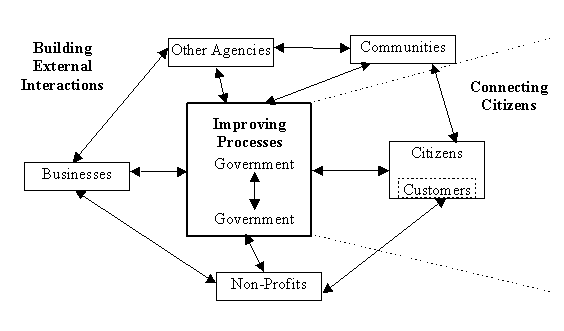In the Overview section:
What is eGovernment?
A. What is eGovernment?
eGovernment is the use of information and communication technologies (ICTs) to improve the activities of public sector organisations.
Some definitions restrict e-government to Internet-enabled applications only, or only to interactions between government and outside groups. Here, we do not - all digital ICTs are included; all public sector activities are included.
In our definition, then, governments have been practising e-government for more than 50 years: using that first mainframe in the Statistics Office was "e-government". We just didn't give it that name 50 years ago.
B. What Does eGovernment Cover?
There are three main domains of e-government, illustrated in Figure 1 (adapted from: Ntiro, S. (2000) eGovernment in Eastern Africa, KPMG, Dar-es-Salaam) :
- Improving government processes: eAdministration
- Connecting citizens: eCitizens and eServices
- Building external interactions: eSociety
Respectively, these particularly address the problems that government is too costly, too inefficient and too ineffective (e-admininstration); too self-serving and too inconvenient (e-citizens and e-services); and too insular (e-society).
Figure 1: Focal Domains for eGovernment Initiatives

In a little more detail, the domains of e-government are as follows.
B1. Improving Government Processes: eAdministration
eGovernment initiatives within this domain deal particularly with improving the internal workings of the public sector. They include:
- Cutting process costs : improving the input:output ratio by cutting financial costs and/or time costs.
- Managing process performance : planning, monitoring and controlling the performance of process resources (human, financial and other).
- Making strategic connections in government : connecting arms, agencies, levels and data stores of government to strengthen capacity to investigate, develop and implement the strategy and policy that guides government processes.
- Creating empowerment : transferring power, authority and resources for processes from their existing locus to new locations.
B2. Connecting Citizens: eCitizens and eServices
Such initiatives deal particularly with the relationship between government and citizens: either as voters/stakeholders from whom the public sector should derive its legitimacy, or as customers who consume public services. These initiatives may well incorporate the process improvements identified in section B1. However, they also include a broader remit:
- Talking to citizens : providing citizens with details of public sector activities. This mainly relates to certain types of accountability: making public servants more accountable for their decisions and actions.
- Listening to citizens : increasing the input of citizens into public sector decisions and actions. This could be flagged as either democratisation or participation.
- Improving public services : improving the services delivered to members of the public along dimensions such as quality, convenience and cost.
B3. Building External Interactions: eSociety
Such initiatives deal particularly with the relationship between public agencies and other institutions - other public agencies, private sector companies, non-profit and community organisations. As with citizen connections, these initiatives may well incorporate the process improvements identified in section B1. However, they also include a broader remit:
- Working better with business : improving the interaction between government and business. This includes digitising regulation of, procurement from, and services to, business to improve quality, convenience and cost.
- Developing communities : building the social and economic capacities and capital of local communities.
- Building partnerships : creating organisational groupings to achieve economic and social objectives. The public sector is almost always one of the partners, though occasionally it acts only as a facilitator for others.
C. How Do I Spell "eGovernment"?
There are many variations. The forms we try to stick to here are:
- CAPITALS: "eGOVERNMENT"
- Titles/Start of Sentences: "eGovernment"
- lower case: "e-government"